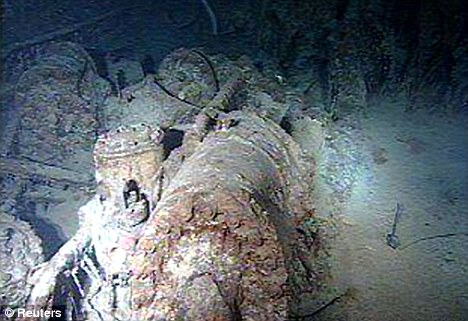- Joined
- Mar 26, 2010
- Messages
- 9,797 (1.90/day)
- Location
- Jakarta, Indonesia
| System Name | micropage7 |
|---|---|
| Processor | Intel Xeon X3470 |
| Motherboard | Gigabyte Technology Co. Ltd. P55A-UD3R (Socket 1156) |
| Cooling | Enermax ETS-T40F |
| Memory | Samsung 8.00GB Dual-Channel DDR3 |
| Video Card(s) | NVIDIA Quadro FX 1800 |
| Storage | V-GEN03AS18EU120GB, Seagate 2 x 1TB and Seagate 4TB |
| Display(s) | Samsung 21 inch LCD Wide Screen |
| Case | Icute Super 18 |
| Audio Device(s) | Auzentech X-Fi Forte |
| Power Supply | Silverstone 600 Watt |
| Mouse | Logitech G502 |
| Keyboard | Sades Excalibur + Taihao keycaps |
| Software | Win 7 64-bit |
| Benchmark Scores | Classified |


Identified using DNA technology, the bacteria and has been found on clumps of rust - known as rusticles - that have covered Titanic's iron hull in the century since it sunk in 1912.
The bacteria - Halomonas titanicae - is said to be fast consuming the rust and the iron.
Consequently, scientists believe the wreck - that is in two separate sections - will be nothing more that a huge 'rust stain' on the seabed within 20 years.
The discovery is the result of two decades' worth of research on the micro-organisms on Titanic, which sank in the North Atlantic on her maiden voyage.
It was made by Dr Henrietta Mann and Bhavleen Kaur from Dalhousie University, in Halifax, Nova Scotia, in conjunction with researchers from the University of Sevilla, Spain.
Dr Mann, adjunct professor with the department of civil engineering, said: 'I think Titanic has maybe 15 or 20 years left. I don't think it will have too much longer than that.
'It has already lasted for 100 years, but eventually there will be nothing left but a rust stain on the bottom of the Atlantic.'
The bacteria was discovered in rusticles collected from the wreck of by a team of scientists in 1991.
Dr Mann and her team began studying them in 1995, but it is only within the last few years that DNA technology has progressed enough for the bacteria to be isolated and studied fully.
The rusticles - porous, dark orange, icicle-like structures that form on rusting iron - covered the metal surface of Titanic and are home to a host of micro-organisms.
This includes 27 strains of bacteria, from which Halomonas titanicae was isolated and found to be particularly partial to iron.
Its destructive tendencies mean the delicate rusticles will eventually disintegrate into a fine powder in the salt water
Dr Mann said: 'The rusticles on Titanic are made from a composition of different micro-organisms. It's not just one species of bacteria munching on it.
'But we have now identified one which particularly likes eating iron.
'To explain it in human terms, not every type of bacteria has the same taste. So if you present different people with a plate of chocolate and cheese, some may prefer one and some the other.
'This is a type of bacteria which particularly likes eating iron.
'Nature is very clever, and everything is recalled eventually. Nature makes it, and nature claims it back.
'In this case, the bacteria helps to decompose the ship.'
While the preservation of Titanic is now thought to be impossible, it is hoped the discovery could lead to scientists being able to prevent the destruction of other iron structures
http://www.dailymail.co.uk/sciencetech/article-1346446/Titanic-wreck-completely-destroyed-20-years-new-rust-eating-bacteria.html
http://www.dailymail.co.uk/sciencetech/article-1336542/Halomonas-titanicae-New-rust-eating-bacteria-destroying-wreck-Titanic.html
http://www.livescience.com/9079-species-rust-eating-bacteria-destroying-titanic.html

